Off the Beaten Path on New Zealand’s South Island
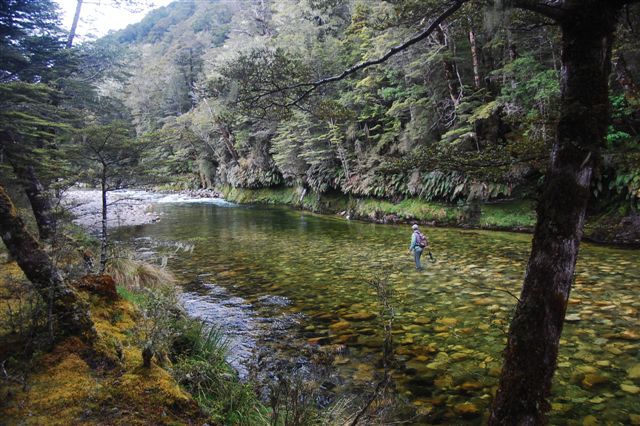
New Zealand's South Island offers not just classic Kiwi-style trout stalking on famous rivers, but even more remote challenges in places like Fiordland National Park. Lisa Weber photo.
YOUR FIRST FLY FISHING adventure to the islands of New Zealand can be an intimidating experience no matter how much you’ve fished or where. First off, there’s the reasonable expectation of huge fish on light rods and small flies. That’s enough to get even the hardcore trout bum lying awake at night. Then there’s the very real possibility that the best-laid plans, your pricey international plane ticket and a grueling journey half way around the world — including the obligatory jet-lag — will be all for naught due to bad weather, blown rivers and other disasters.
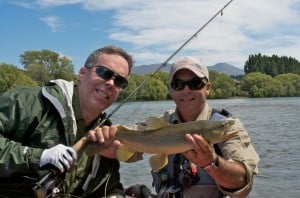
New Zealand guide Greg Dougherty holds a Clutha River brown taken by Clay Stauffer on his first day of fly fishing down under. Clay Stauffer photo.
My most recent trip to New Zealand this past winter — the seventh in my lifetime — reminded me of these varied challenges and left me more determined than ever to seek out new options for insuring a disaster-free trip to the land the native Maoris call “aotearoa,” the land of the long white cloud. Joining me on this particular adventure was a long-time fishing buddy who had always dreamed of making the pilgrimage down under and had high, if guarded, expectations given my endless big fish stories and unbridled enthusiasm for this country and its people.
One of the first orders of business was to help my fishing partner understand the Kiwi concept of stalking fish. As anyone who’s ever read anything about New Zealand fly fishing knows, the traditional upstream approach (also known as “walk & wade”) is the preferred and normally most productive tactic there. More trout “hunting” than fishing, it requires some serious patience as you sneak along the bank in search of an individual fish — or sign of a fish — before you even make your first cast. And it works because the water is always Tanqueray-gin clear, the fish predictably skittish and the opportunities limited by low densities of trout and food. This is not to say blind-casting won’t work on New Zealand waters (it does), but it’s how most Kiwi guides like to fish. Why? Because it avoids wasting time or blowing a good fish right under your nose.
So, with all this in mind, I went in search of some new and different options for this particular trip. I wanted to make our time down under a bit less intimidating, more productive and economical for my fishing partner. Fortunately, my first problem was solved with a couple of emails to my friends Wayne and Mandy Enoka of the perfectly situated Te Wanaka Lodge, and a day of fishing with guide Greg Dougherty of Alpine Fishing Guides.
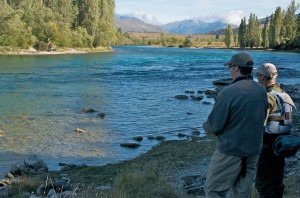
Robert Tomes and guide Greg Dougherty discuss strategy before wade fishing a run on New Zealand's Clutha River. Clay Stauffer photo.
Located in the Central Otago wine-growing region of the South Island, in the picturesque ski-town of Wanaka, Alpine Guides is one of the few guide services permitted to run commercial, fly-fishing float trips in all of New Zealand. (Note: commercial float fishing operations also exist in the Lake Brunner region on the West Coast of the South Island and on the North Island, near Lake Taupo on the famous Tongariro River). In operation since 1996, Greg guides various local waters including the famed Makaroa and Matukituki but spends most of his time floating the wide, fish-filled and largely inaccessible Clutha River. Known for its abundance of both wild browns and rainbows, this river turned out to be the perfect place to work out a few kinks after the long flight, enjoy some great South Island fishing, and at the same time get reacquainted with the ins and outs of handling large trout on light tackle. In contrast to a typical, often arduous New Zealand fishing day of hiking, wading and casting to trout (that may or may not take your fly depending on your presentation skills), a day’s float with Greg was relaxing and almost always productive. This mid-February day we floated some ten miles of the mighty Clutha in Greg’s comfortable, framed-rubber raft, mainly blind-casting large Cicada and other terrestrial patterns tight to the shore and any midstream structure or current seams that looked fishy.
This was the first time I’d ever floated a New Zealand river and I had a blast — pretty much like floating a river in the western U.S. but without any competition (as in zero) and larger fish on average. On certain shallower runs and riffles, we also spent some time out of the boat stalking fish by foot in the traditional Kiwi walk & wade approach. The results were impressive — “cracker” as they like to say — with most fish over 18 inches and many over 20. Larger fish — known locally as “double-digits” — are always a possibility here, especially in the fall (March through May down under) but we didn’t manage to hook any. Our fishing proved to be all that I’d hoped for and the perfect introductory course for my friend, and would be for anyone more comfortable floating than wading.
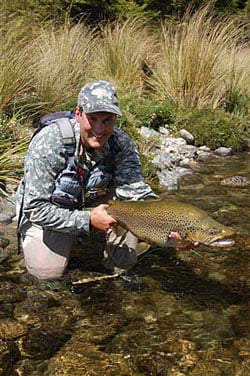
Fiordland guide Lawton Weber with a monster brown taken on a dry during New Zealand's famed "mouse hatch." Lisa Weber photo.
My second challenge of this trip was a little more daunting: finding a good resource for fishing the still partially unexplored waters of the region known as Fiordland National Park. Located in the extreme southwest corner of the South Island, near the town of Te Anau, this majestic, fiord-filled, temperate rainforest is as close as you’ll ever come to a real life “Jurassic Park” (my last trip there I’m sure I saw a Velociraptor stalking me along the shore). The main attraction here, however, is not extinct species but very real and very large trout that have rarely seen a fly, much less an angler. I’d dreamed of returning many times but finding a guide who knew the water was different matter all together given the massive area — nearly 8,000 square miles — and ever-changing weather and river conditions.
As luck would have it, my contacts throughout New Zealand put me in touch with peripatetic guide and Fiordland expertLawton Weber.
For the past 12 years Lawton has had the enviable job of guiding anglers in both Vermont and New Zealand, where he spends all winter chasing big trout around the lower South Island.
His name may be familiar to some, as he was the first to discover the dreaded didymo (aka “rock snot”) outbreak in the U.S. when he stumbled upon it on the Upper Connecticut River back in 2007. This bad news, along with evidence of infestations in other rivers across the country, is what initially prompted the move towards rubber-soled wading boots which are now required by law in New Zealand.
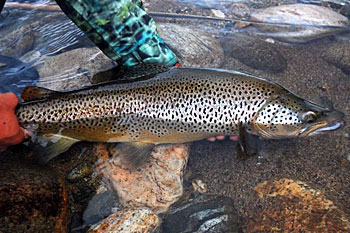
Lisa Weber photo
Our time together near Fiordland was the stuff of fly fishing fantasies, albeit a little wet. This region receives an astonishing 200-plus inches of rain annually, making it one of the wettest places on earth. A short drive from Te Anau we found ourselves alone on a narrow, winding spring creek that looked like it was right out of a glossy New Zealand travel brochure. Wading quietly upstream, we spotted plenty of good fish nymphing in shallow gravel runs and rising quietly under overhanging willows or tight to wood. Lawton’s keen eyes — even without decent light — and gentle encouragement helped me to catch more than my share of the hefty, sea-run browns that inhabited this special piece of water.
Towards day’s end, we were both soaked to the bone when Lawton suggested we check out a feeder creek that looked too small to hold anything, much less a Kiwi-size trout. To only my surprise, hidden in a shallow pocket under the cover of thick willows was a nice fish rising steadily in the rain. This was a textbook New Zealand fishing opportunity and I made what was sure to be my one and only cast, aiming short so as not to get hung up. The big brown sensed my dry immediately, swung around and ate — just like in my dreams.
So, ready to make your own trek down under? Before you do, here are a few important tips:
- Gear up! While a fast-action, graphite 5-weight is perfectly adequate for making stealthy presentations on most Kiwi rivers, these days I also carry a 6-weight rod in my arsenal if only to better combat the challenge of casting larger dries like Cicadas and weighted nymphs on long leaders in windy conditions.
- Got backing? While double-digit trout don’t happen every day down under, the possibility of a fish of a lifetime should make you reconsider if your current trout reel is up to the task. Do yourself a favor and invest in a high quality, large-arbor reel with a smooth drag and plenty of backing capacity before making your trip.
- Stealth wins the day. Don’t even think about showing up to fish with a Kiwi guide with a brightly colored fly line.
- Leave your No-Hackles at home. While we all like to carry tons of flies in our vest, New Zealand fly selection is very basic, if not “old-school,” and presentation is the real key. I recommend getting what you need from the local experts and saving yourself the hassle.











